Machine Learning Week_1 Linear Algebra Review 1-6
4 Linear Algebra Review
4.1 Video: Matrices and Vectors
Let's get started with our linear algebra review. In this video I want to tell you what are matrices and what are vectors.
A matrix is a rectangular array of numbers written between square brackets. So, for example, here is a matrix on the right, a left square bracket. And then, write in a bunch of numbers. These could be features from a learning problem or it could be data from somewhere else, but the specific values don't matter, and then I'm going to close it with another right bracket on the right. And so that's one matrix.
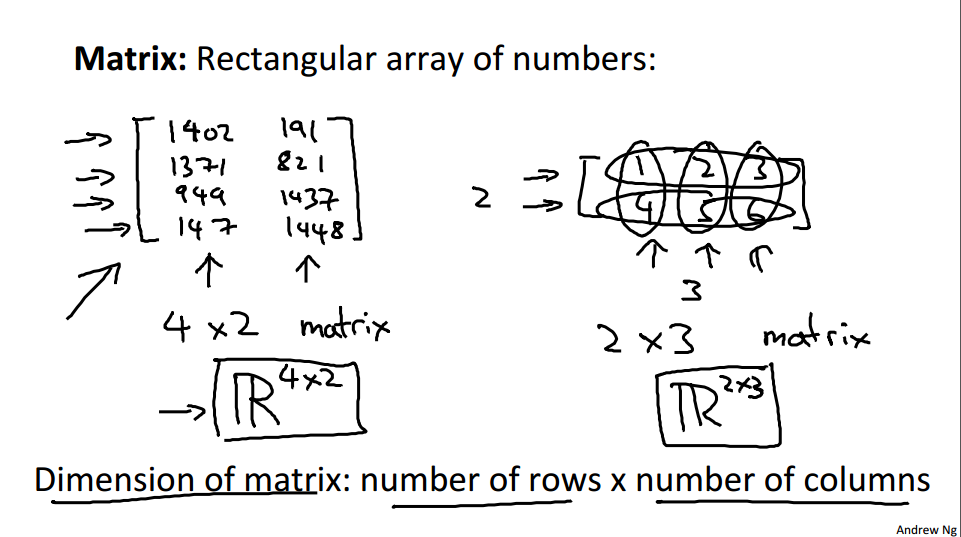
And, here's another example of the matrix, let's write 1, 2,3, 4, 5, 6. So matrix is just another way for saying, is a 2D or a two dimensional array. And the other piece of knowledge that we need is that the dimension of the matrix is going to be written as the number of row times the number of columns in the matrix. So, concretely, this example on the left, this has 1, 2, 3, 4 rows and has 2 columns, and so this example on the left is a 4 by 2 matrix - number of rows by number of columns. So, four rows, two columns. This one on the right, this matrix has two rows. That's the first row, that's the second row, and it has three columns. That's the first column, that's the second column, that's the third column So, this second matrix we say it is a 2 by 3 matrix. So we say that the dimension of this matrix is 2 by 3.
Sometimes you also see this written out, in the case of left, you will see this written out as R4 by 2 or concretely what people will sometimes say this matrix is an element of the set R 4 by 2. So, this thing here, this just means the set of all matrices that of dimension 4 by 2 and this thing on the left, sometimes this is written out as a matrix that is an R 2 by 3. So if you ever see, 2 by 3. So if you ever see something like this are 4 by 2 or are 2 by 3, people are just referring to matrices of a specific dimension.
Next, let's talk about how to refer to specific elements of the matrix. And by matrix elements, other than the matrix, I just mean the entries, so the numbers inside the matrix. So, in the standard notation, if A is this matrix here, then A subscript ij is going to refer to the i, j entry, meaning the entry in the matrix in the ith row and jth column.
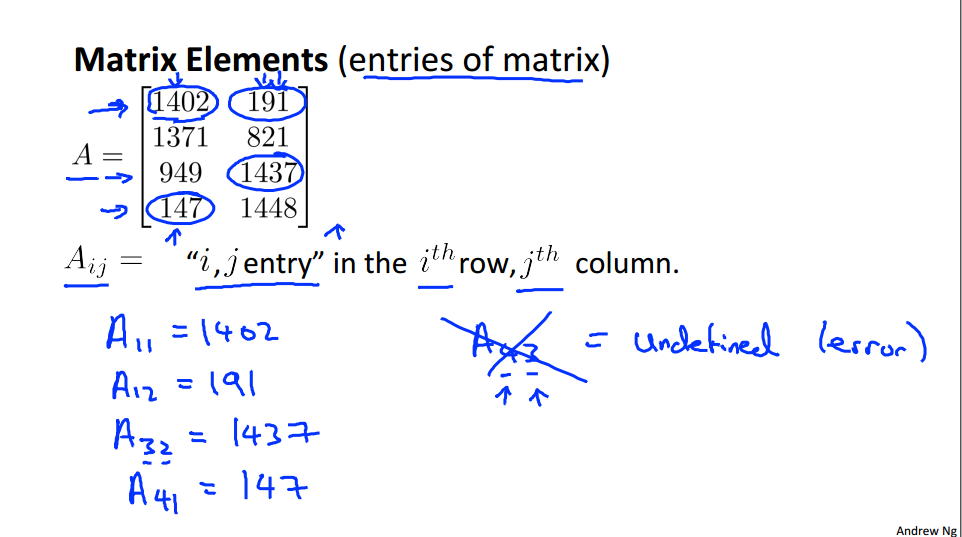
So for example A_11 is going to refer to the entry in the 1st row and the 1st column, so that's the first row and the first column and so A_11 is going to be equal to 1 4 0 2. Another example, 8 1 2 is going to refer to the entry in the first row and the second column and so A_12 is going to be equal to one nine one. This come from a quick examples. Let's see, A, oh let's say A_32, is going to refer to the entry in the 3rd row, and second column, right, because that's 3 2 so that's equal to 1 4 3 7. And finally, 8 4 1 is going to refer to this one right, fourth row, first column is equal to 1 4 7 and if, hopefully you won't, but if you were to write, and say well this A_43, well, that refers to the fourth row, and the third column, that you know, this matrix has no third column so this is undefined, you know, or you can think of this as an error. There's no such element as A_43, so, you know, you shouldn't be referring to A_4 3.
So, the matrix gets you a way of letting you quickly organize, index and access lots of data. In case I seem to be tossing up a lot of concepts, a lot of new notations very rapidly, you don't need to memorize all of this, but on the course website where we have posted the lecture notes, we also have all of these definitions written down. So you can always refer back, you know, either to these slides,also course website, audio lecture . Notes if you forget well, A_41 was that? Which row, which column was that? Don't worry about memorizing everything now. You can always refer back to the written materials on the course website, and use that as a reference. So that's what a matrix is.
Next, let's talk about what is a vector. A vector turns out to be a special case of a matrix. A vector is a matrix that has only 1 column so you have an n x 1 matrix, then that's a remember, right?
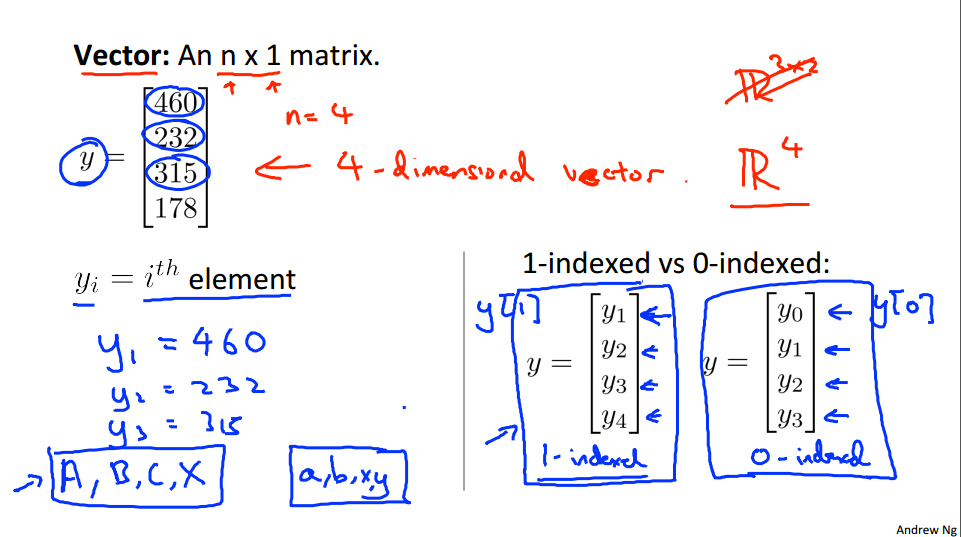
N is the number of rows, and 1 here is the number of columns, so matrix with just one column is what we call a vector. So here's an example of a vector, with I guess I have n equals 4 elements here. so we also call this thing, another term for this is a four dmensional vector, just means that this is a vector with four elements, with four numbers in it. And, just as earlier for matrices you saw this notation R 3 by 2 to refer to 3 by 2 matrices, for this vector we are going to refer to this as a vector in the set R4. So this R4 means a set of four-dimensional vectors.
Next let's talk about how to refer to the elements of the vector. We are going to use the notation y_i to refer to the ith element of the vector y. So if y is this vector, y subscript i is the ith element. So y_1 is the first element, four sixty, y_2 is equal to the second element, two thirty two. There's the first. There's the second. Y3 is equal to 315 and so on, and only y_1 through y_4 are defined consistency 4-dimensional vector.
Also it turns out that there are actually two conventions for how to index into a vector and here they are. Sometimes, people will use one index and sometimes zero index factors. So this example on the left is a one in that specter where the element we write is y_1, y_2, y_3, y_4. And this example in the right is an example of a zero index factor where we start the indexing of the elements from zero. So the elements go from a zero up to y three. And this is a bit like the arrays of some primary languages where the arrays can either be indexed starting from one. The first element of an array is sometimes a Y1, this is sequence notation I guess, and sometimes it's zero index depending on what programming language you use. So it turns out that in most of math, the one index version is more common For a lot of machine learning applications, zero index vectors gives us a more convenient notation.
So what you should usually do is, unless otherwised specified, you should assume we are using one index vectors. In fact, throughout the rest of these videos on linear algebra review, I will be using one index vectors. But just be aware that when we are talking about machine learning applications, sometimes I will explicitly say when we need to switch to, when we need to use the zero index vectors as well. Finally, by convention, usually when writing matrices and vectors, most people will use upper case to refer to matrices. So we're going to use capital letters like A, B, C, you know, X, to refer to matrices, and usually we'll use lowercase, like a, b, x, y, to refer to either numbers, or just raw numbers or scalars or to vectors. This isn't always true but this is the more common notation where we use lower case "Y" for referring to vector and we usually use upper case to refer to a matrix. So, you now know what are matrices and vectors.
Next, we'll talk about some of the things you can do with them.
unfamiliar words
-
rectangular [rekˈtæŋɡjələr] adj. 矩形的;长方形的
exp: ADJ Something that is rectangular is shaped like a rectangle.
a rectangular table.
长方形桌子 -
bracket [ˈbrækɪt] n. 括号 v. 用括弧括上;把…等同考虑;把…相提并论
-
exp1: N either of a pair of marks, ( ), placed around extra information in a piece of writing or part of a problem in mathematics 括号
Add the numbers in brackets first.
先把括号里的数字加起来。 -
exp2: V to consider people or things to be similar or connected in some way
It is unfair to bracket together those who cannot work with those who will not.
把不能工作的人和不愿工作的人等同看待是不公平的。
-
-
toss [tɒs] v. 扔,抛,掷
I tossed the book aside and got up.
我把书丢在一边,站了起来。 -
convention [kənˈvenʃn] n. 习俗;常规;惯例;大会
-
social conventions
社会习俗 -
to hold a convention
召开大会
-
4.2 Reading: Matrices and Vectors
Matrices are 2-dimensional arrays:
The above matrix has four rows and three columns, so it is a 4 x 3 matrix.
A vector is a matrix with one column and many rows:
So vectors are a subset of matrices. The above vector is a 4 x 1 matrix.
Notation and terms:
-
-
A vector with 'n' rows is referred to as an 'n'-dimensional vector.
-
-
In general, all our vectors and matrices will be 1-indexed. Note that for some programming languages, the arrays are 0-indexed.
-
Matrices are usually denoted by uppercase names while vectors are lowercase.
-
"Scalar" means that an object is a single value, not a vector or matrix.
-
-
Run the cell below to get familiar with the commands in Octave/Matlab. Feel free to create matrices and vectors and try out different things.
% The ; denotes we are going back to a new row.
A = [1, 2, 3; 4, 5, 6; 7, 8, 9; 10, 11, 12]
% Initialize a vector
v = [1;2;3]
% Get the dimension of the matrix A where m = rows and n = columns
[m,n] = size(A)
% You could also store it this way
dim_A = size(A)
% Get the dimension of the vector v
dim_v = size(v)
% Now let's index into the 2nd row 3rd column of matrix A
A_23 = A(2,3)
- - - - - - - - - - - - - - - - - - - - - - - - - - - - - - - - - -
After run.
- - - - - - - - - - - - - - - - - - - - - - - - - - - - - - - - - -
A =
1 2 3
4 5 6
7 8 9
10 11 12
v =
1
2
3
m = 4
n = 3
dim_A =
4 3
dim_v =
3 1
A_23 = 6
unfamiliar words
4.3 Video: Addition and Scalar Multiplication
In this video we'll talk about matrix addition and subtraction, as well as how to multiply a matrix by a number, also called Scalar Multiplication. Let's start an example.
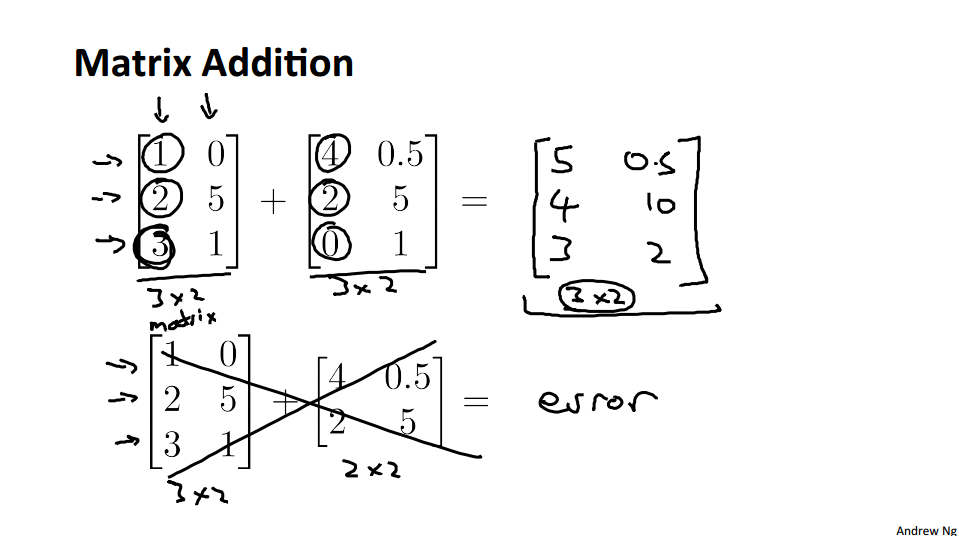
Given two matrices like these, let's say I want to add them together. How do I do that? And so, what does addition of matrices mean? It turns out that if you want to add two matrices, what you do is you just add up the elements of these matrices one at a time. So, my result of adding two matrices is going to be itself another matrix and the first element again just by taking one and four and adding them together, so I get five. The second element I get by taking two and two and adding them, so I get four; three plus three plus zero is three, and so on. I'm going to stop changing colors, I guess. And, on the right is open five, ten and two.
And it turns out you can add only two matrices that are of the same dimensions. So this example is a three by two matrix,because this has 3 rows and 2 columns, so it's 3 by 2. This is also a 3 by 2 matrix, and the result of adding these two matrices is a 3 by 2 matrix again. So you can only add matrices of the same dimension, and the result will be another matrix that's of the same dimension as the ones you just added.
Where as in contrast, if you were to take these two matrices, so this one is a 3 by 2 matrix, okay, 3 rows, 2 columns. This here is a 2 by 2 matrix. And because these two matrices are not of the same dimension, you know, this is an error, so you cannot add these two matrices and, you know, their sum is not well-defined.So that's matrix addition.
Next, let's talk about multiplying matrices by a scalar number. And the scalar is just a, maybe a overly fancy term for, you know, a number or a real number. Alright, this means real number.
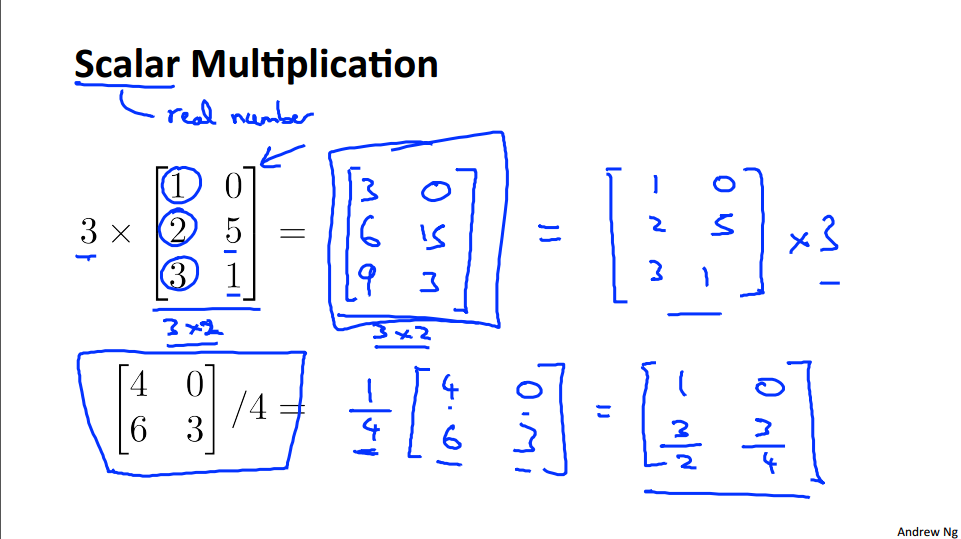
So let's take the number 3 and multiply it by this matrix. And if you do that, the result is pretty much what you'll expect. You just take your elements of the matrix and multiply them by 3, one at a time. So, you know, one times three is three. What, two times three is six, 3 times 3 is 9, and let's see, I'm going to stop changing colors again. Zero times 3 is zero. Three times 5 is 15, and 3 times 1 is three. And so this matrix is the result of multiplying that matrix on the left by 3. And you notice, again, this is a 3 by 2 matrix and the result is a matrix of the same dimension. This is a 3 by 2, both of these are 3 by 2 dimensional matrices. And by the way, you can write multiplication, you know, either way. So, I have three times this matrix. I could also have written this matrix and 1,0, 2, 5, 3, 1, right. I just copied this matrix over to the right. I can also take this matrix and multiply this by three. So whether it's you know, 3 times the matrix or the matrix times three is the same thing and this thing here in the middle is the result.
You can also take a matrix and divide it by a number. So, turns out taking this matrix and dividing it by four, this is actually the same as taking the number one quarter, and multiplying it by this matrix. 4, 0, 6, 3 and so, you can figure the answer, the result of this product is, one quarter times four is one, one quarter times zero is zero. One quarter times six is, what, three halves, about six over four is three halves, and one quarter times three is three quarters. And so that's the results of computing this matrix divided by four. That give you the result.
Finally, for a slightly more complicated example, you can also take these operations and combine them together. So in this calculation, I have three times a vector plus a vector minus another vector divided by three. So just make sure we know where these are, right. This multiplication.
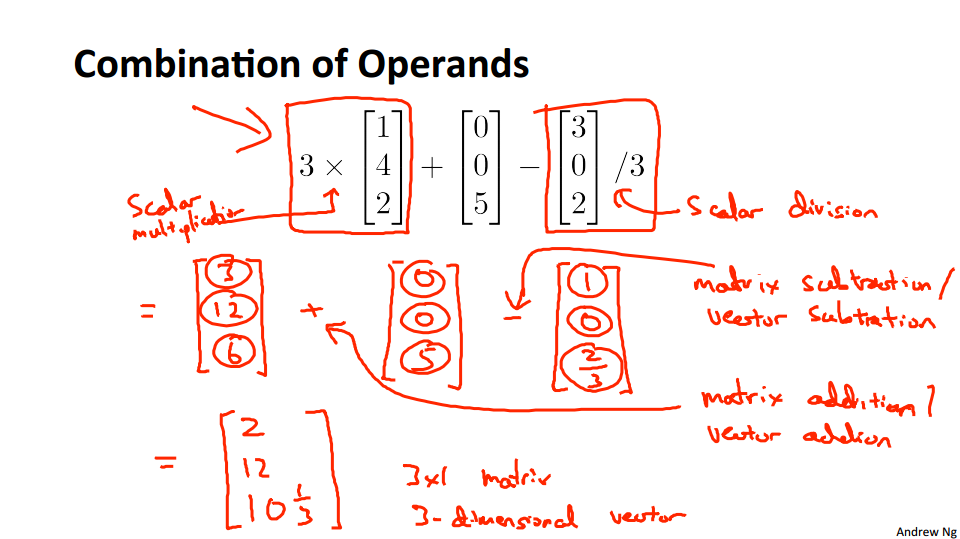
This is an example of scalar multiplication because I am taking three and multiplying it. And this is, you know, another scalar multiplication. Or more like scalar division, I guess. It really just means one zero times this. And so if we evaluate these two operations first, then what we get is this thing is equal to, let's see, so three times that vector is three, twelve, six, plus my vector in the middle which is a 005 minus one, zero, two-thirds, right? And again, just to make sure we understand what is going on here, this plus symbol, that is matrix addition, right? I really, since these are vectors, remember, vectors are special cases of matrices, right? This, you can also call this vector addition This minus sign here, this is again a matrix subtraction, but because this is an n by 1, really a three by one matrix, that this is actually a vector, so this is also vector, this column. We call this matrix a vector subtraction, as well. OK? And finally to wrap this up. This therefore gives me a vector, whose first element is going to be 3+0-1, so that's 3-1, which is 2. The second element is 12+0-0, which is 12. And the third element of this is, what, 6+5-(2/3), which is 11-(2/3), so that's 10 and one-third and see, you close this square bracket. And so this gives me a 3 by 1 matrix, which is also just called a 3 dimensional vector, which is the outcome of this calculation over here.
So that's how you add and subtract matrices and vectors and multiply them by scalars or by real numbers. So far I have only talked about how to multiply matrices and vectors by scalars, by row numbers. In the next video we will talk about a much more interesting step, of taking 2 matrices and multiplying 2 matrices together.
unfamiliar words
-
qarter [ˈkwɔːtə(r)] n. 一刻钟;四等份之一;(正点之前或之后的)15分钟,一刻钟;三个月时间;季度;季 v. 把…切成(或分成)四部分;给…提供食宿
-
exp1: N one of four equal parts of sth
a quarter of a mile
四分之一英里
It's quarter of four now─I'll meet you at quarter after.
现在是三点四十五分,我将在四点十五分和你碰面。 -
exp2: V to cut or divide sth into four parts
She peeled and quartered an apple.
她削去苹果皮,把它切成四瓣。
-
-
evaluate [ɪˈvæljueɪt] vt. 估计;评价;评估
Our research attempts to evaluate the effectiveness of the different drugs.
我们的研究试图对不同药物的疗效进行评估
4.4 Reading:Addition and Scalar Multiplication
Addition and subtraction are element-wise, so you simply add or subtract each corresponding element:
Subtracting Matrices:
To add or subtract two matrices, their dimensions must be the same.
In scalar multiplication, we simply multiply every element by the scalar value:
In scalar division, we simply divide every element by the scalar value:
Experiment below with the Octave/Matlab commands for matrix addition and scalar multiplication. Feel free to try out different commands. Try to write out your answers for each command before running the cell below.
% Initialize matrix A and B
A = [1, 2, 4; 5, 3, 2]
B = [1, 3, 4; 1, 1, 1]
% Initialize constant s
s = 2
% See how element-wise addition works
add_AB = A + B
% See how element-wise subtraction works
sub_AB = A - B
% See how scalar multiplication works
mult_As = A * s
% Divide A by s
div_As = A / s
% What happens if we have a Matrix + scalar?
add_As = A + s
- - - - - - - - - - - - - - - - - - - - - - - - - - - - - - - - - -
After run.
- - - - - - - - - - - - - - - - - - - - - - - - - - - - - - - - - -
A =
1 2 4
5 3 2
B =
1 3 4
1 1 1
s = 2
add_AB =
2 5 8
6 4 3
sub_AB =
0 -1 0
4 2 1
mult_As =
2 4 8
10 6 4
div_As =
0.50000 1.00000 2.00000
2.50000 1.50000 1.00000
add_As =
3 4 6
7 5 4
unfamiliar words
4.5 Video: Matrix Vector Multiplication
In this video, I'd like to start talking about how to multiply together two matrices. We'll start with a special case of that, of matrix vector multiplication - multiplying a matrix together with a vector. Let's start with an example.
Here is a matrix, and here is a vector, and let's say we want to multiply together this matrix with this vector, what's the result? Let me just work through this example and then we can step back and look at just what the steps were.
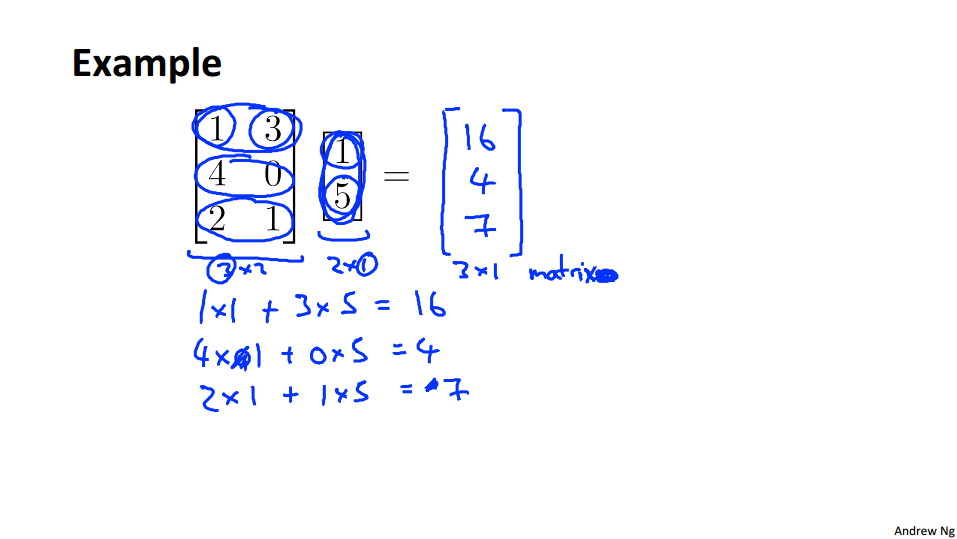
It turns out the result of this multiplication process, is going to be, itself, a vector. And I'm just going work with this first and later we'll come back and see just what I did here. To get the first element of this vector I am going to take these two numbers and multiply them with the first row of the matrix and add up the corresponding numbers. Take one multiplied by one, and take three and multiply it by five, and that's what, that's one plus fifteen so that gives me sixteen. I'm going to write sixteen here. then for the second row, second element, I am going to take the second row and multiply it by this vector, so I have four times one, plus zero times five, which is equal to four, so you'll have four there. And finally for the last one I have two one times one five, so two by one, plus one by 5, which is equal to a 7, and so I get a 7 over there. It turns out that the results of multiplying that's a 3x2 matrix by a 2x1 matrix is also just a two-dimensional vector. The result of this is going to be a 3x1 matrix, so that's why three by one 3x1 matrix, in other words a 3x1 matrix is just a three dimensional vector.
So I realize that I did that pretty quickly, and you're probably not sure that you can repeat this process yourself, but let's look in more detail at what just happened and what this process of multiplying a matrix by a vector looks like.
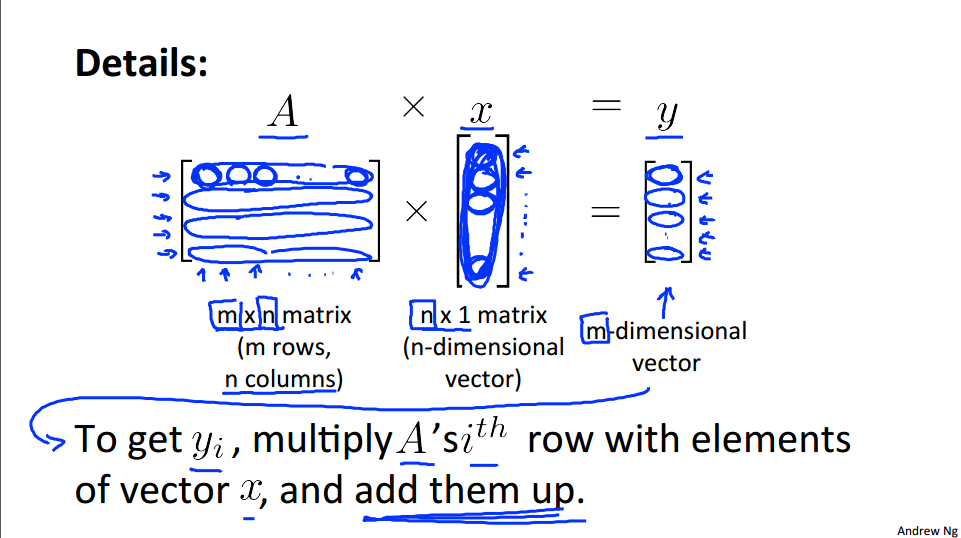
Here's the details of how to multiply a matrix by a vector. Let's say I have a matrix A and want to multiply it by a vector x. The result is going to be some vector y. So the matrix A is a m by n dimensional matrix, so m rows and n columns and we are going to multiply that by a n by 1 matrix, in other words an n dimensional vector. It turns out this "n" here has to match this "n" here. In other words, the number of columns in this matrix, so it's the number of n columns. The number of columns here has to match the number of rows here. It has to match the dimension of this vector. And the result of this product is going to be an n-dimensional vector y. Rows here. "m" is going to be equal to the number of rows in this matrix "A". So how do you actually compute this vector "Y"? Well it turns out to compute this vector "y", the process is to get "Y""I", multiply "A's" "ith" row with the elements of the vector "x" and add them up.
So here's what I mean. In order to get the first element of "y", that first number--whatever that turns out to be. Wwe're gonna take the first row of the matrix "A" and multiply them one at a time with the elements of this vector "x". So I take this first number multiply it by this first number. Then take the second number multiply it by this second number. Take this third number whatever that is, multiply it the third number and so on until you get to the end. And I'm gonna add up the results of these products and the result of paying that out is going to give us this first element of "y". Then when we want to get the second element of "y", let's say this element. The way we do that is we take the second row of A and we repeat the whole thing. So we take the second row of A, and multiply it elements-wise, so the elements of x and add up the results of the products and that would give me the second element of y. And you keep going to get and we going to take the third row of A, multiply element with the vector x, sum up the results and then I get the third element and so on, until I get down to the last row like so, okay? So that's the procedure. Let's do one more example.
Here's the example: So let's look at the dimensions. Here, this is a three by four dimensional matrix. This is a four-dimensional vector, or a 4 x 1 matrix, and so the result of this, the result of this product is going to be a three-dimensional vector.
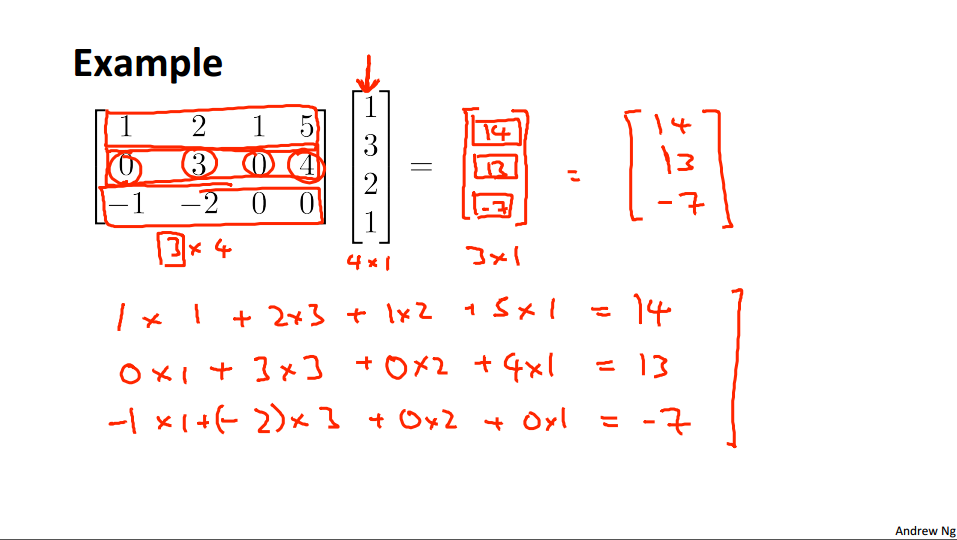
Write, you know, the vector, with room for three elements. Let's do the, let's carry out the products. So for the first element, I'm going to take these four numbers and multiply them with the vector X. So I have 1x1, plus 2x3, plus 1x2, plus 5x1, which is equal to - that's 1+6, plus 2+6, which gives me 14. And then for the second element, I'm going to take this row now and multiply it with this vector (0x1)+3. All right, so 0x1+ 3x3 plus 0x2 plus 4x1, which is equal to, let's see that's 9+4, which is 13. And finally, for the last element, I'm going to take this last row, so I have minus one times one. You have minus two, or really there's a plus next to a two I guess. Times three plus zero times two plus zero times one, and so that's going to be minus one minus six, which is going to make this seven, and so that's vector seven. Okay? So my final answer is this vector fourteen, just to write to that without the colors, fourteen, thirteen, negative seven.
And as promised, the result here is a three by one matrix. So that's how you multiply a matrix and a vector. I know that a lot just happened on this slide, so if you're not quite sure where all these numbers went, you know, feel free to pause the video you know, and so take a slow careful look at this big calculation that we just did and try to make sure that you understand the steps of what just happened to get us these numbers,fourteen, thirteen and eleven.
Finally, let me show you a neat trick. Let's say we have a set of four houses so 4 houses with 4 sizes like these. And let's say I have a hypotheses for predicting what is the price of a house, and let's say I want to compute, you know, H of X for each of my 4 houses here. It turns out there's neat way of posing this, applying this hypothesis to all of my houses at the same time. It turns out there's a neat way to pose this as a Matrix Vector multiplication.

So, here's how I'm going to do it. I am going to construct a matrix as follows. My matrix is going to be 1111 times, and I'm going to write down the sizes of my four houses here and I'm going to construct a vector as well, And my vector is going to this vector of two elements, that's minus 40 and 0.25. That's these two co-efficients; data 0 and data 1. And what I am going to do is to take matrix and that vector and multiply them together, that times is that multiplication symbol. So what do I get? Well this is a four by two matrix. This is a two by one matrix. So the outcome is going to be a four by one vector, all right. So, let me, so this is going to be a 4 by 1 matrix is the outcome or really a four diminsonal vector, so let me write it as one of my four elements in my four real numbers here. Now it turns out and so this first element of this result, the way I am going to get that is, I am going to take this and multiply it by the vector. And so this is going to be -40 x 1 + 4.25 x 2104. By the way, on the earlier slides I was writing 1 x -40 and 2104 x 0.25, but the order doesn't matter, right? -40 x 1 is the same as 1 x -40. And this first element, of course, is "H" applied to 2104. So it's really the predicted price of my first house. Well, how about the second element? Hope you can see where I am going to get the second element. Right? I'm gonna take this and multiply it by my vector. And so that's gonna be -40 x 1 + 0.25 x 1416. And so this is going be "H" of 1416. Right?
And so on for the third and the fourth elements of this 4 x 1 vector. And just there, right? This thing here that I just drew the green box around, that's a real number, OK? That's a single real number, and this thing here that I drew the magenta box around--the purple, magenta color box around--that's a real number, right? And so this thing on the right--this thing on the right overall, this is a 4 by 1 dimensional matrix, was a 4 dimensional vector.
And, the neat thing about this is that when you're actually implementing this in software--so when you have four houses and when you want to use your hypothesis to predict the prices, predict the price "y" of all of these four houses. What this means is that, you know, you can write this in one line of code. When we talk about octave and program languages later,** you can actually, you'll actually write this in one line of code**. You write prediction equals my, you know, data matrix times parameters, right? Where data matrix is this thing here, and parameters is this thing here, and this times is a matrix vector multiplication. And if you just do this then this variable prediction - sorry for my bad handwriting - then just implement this one line of code assuming you have an appropriate library to do matrix vector multiplication.
If you just do this, then prediction becomes this 4 by 1 dimensional vector, on the right, that just gives you all the predicted prices. And your alternative to doing this as a matrix vector multiplication would be to write eomething like , you know, for I equals 1 to 4, right? And you have say a thousand houses, it would be for i equals 1 to a thousand or whatever. And then you have to write a prediction, you know, of i equals, and then do a bunch more work over there and it turns out that When you have a large number of houses, if you're trying to predict the prices of not just four but maybe of a thousand houses then it turns out that when you implement this in the computer, implementing it like this, in any of the various languages. This is not only true for Octave, but for Supra Server Java or Python, other high-level, other languages as well. It turns out, that, by writing code in this style on the left, it allows you to not only simplify the code, because, now, you're just writing one line of code rather than the form of a bunch of things inside. But, for subtle reasons, that we will see later, it turns out to be much more computationally efficient to make predictions on all of the prices of all of your houses doing it the way on the left than the way on the right than if you were to write your own formula.
I'll say more about this later when we talk about vectorization, but, so, by posing a prediction this way, you get not only a simpler piece of code, but a more efficient one. So, that's it for matrix vector multiplication and we'll make good use of these sorts of operations as we develop the linear regression in other models further. But, in the next video we're going to take this and generalize this to the case of matrix matrix multiplication.
unfamiliar words
- subtle [ˈsʌtl] adj. 不易察觉的;不明显的;微妙的;机智的;机巧的;狡猾的;巧妙的
-
exp1:ADJ not very noticeable or obvious
subtle colours/flavours/smells, etc.
淡淡的色彩、味道、气味等
There are subtle differences between the two versions.
两个版本之间有一些细微的差异。 -
exp2: ADJ behaving in a clever way, and using indirect methods, in order to achieve sth
I decided to try a more subtle approach.
我决定智取。
-
4.6 Reading: Matrix Vector Multiplication
We map the column of the vector onto each row of the matrix, multiplying each element and summing the result.
The result is a vector. The number of columns of the matrix must equal the number of rows of the vector.
An m x n matrix multiplied by an n x 1 vector results in an m x 1 vector.
Below is an example of a matrix-vector multiplication. Make sure you understand how the multiplication works. Feel free to try different matrix-vector multiplications.
% Initialize matrix A
A = [1, 2, 3; 4, 5, 6;7, 8, 9]
% Initialize vector v
v = [1; 1; 1]
% Multiply A * v
Av = A * v
- - - - - - - - - - - - - - - - - - - - - - - - - - - - - - - - - -
After run.
- - - - - - - - - - - - - - - - - - - - - - - - - - - - - - - - - -
A =
1 2 3
4 5 6
7 8 9
v =
1
1
1
Av =
6
15
24
unfamiliar words
大模型时代,文字创作已死。2025年全面停更了,世界不需要知识分享。
如果我的工作对您有帮助,您想回馈一些东西,你可以考虑通过分享这篇文章来支持我。我非常感谢您的支持,真的。谢谢!
作者:Dba_sys (Jarmony)
转载以及引用请注明原文链接:https://www.cnblogs.com/asmurmur/p/15371074.html
本博客所有文章除特别声明外,均采用CC 署名-非商业使用-相同方式共享 许可协议。




【推荐】国内首个AI IDE,深度理解中文开发场景,立即下载体验Trae
【推荐】编程新体验,更懂你的AI,立即体验豆包MarsCode编程助手
【推荐】抖音旗下AI助手豆包,你的智能百科全书,全免费不限次数
【推荐】轻量又高性能的 SSH 工具 IShell:AI 加持,快人一步
· AI与.NET技术实操系列:向量存储与相似性搜索在 .NET 中的实现
· 基于Microsoft.Extensions.AI核心库实现RAG应用
· Linux系列:如何用heaptrack跟踪.NET程序的非托管内存泄露
· 开发者必知的日志记录最佳实践
· SQL Server 2025 AI相关能力初探
· 震惊!C++程序真的从main开始吗?99%的程序员都答错了
· 【硬核科普】Trae如何「偷看」你的代码?零基础破解AI编程运行原理
· 单元测试从入门到精通
· 上周热点回顾(3.3-3.9)
· winform 绘制太阳,地球,月球 运作规律